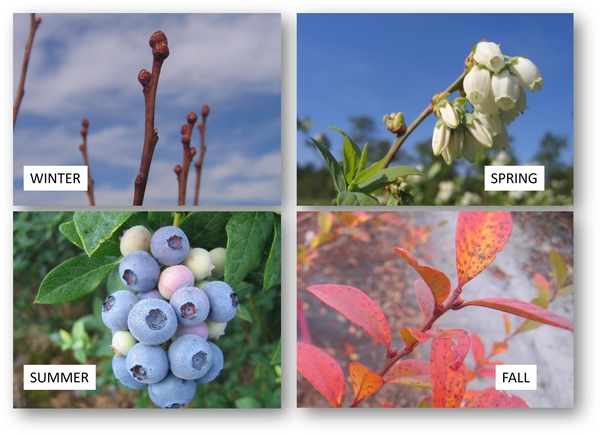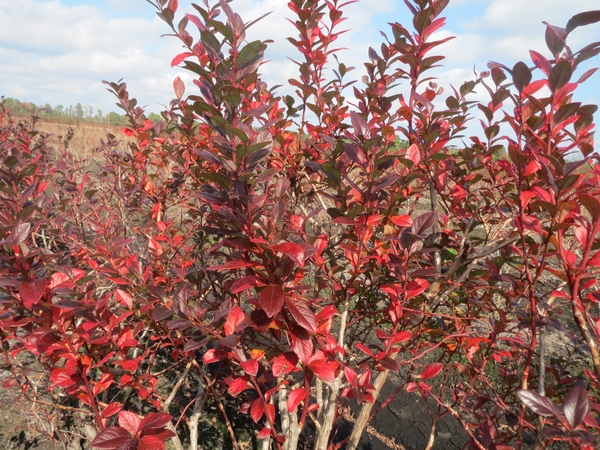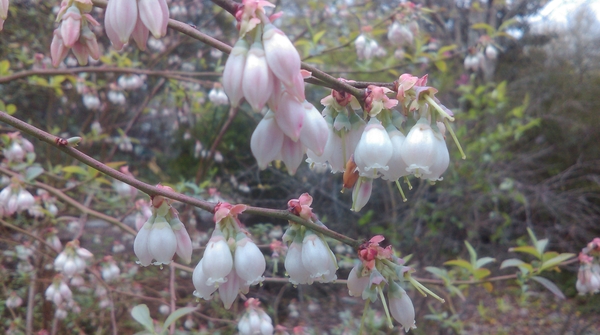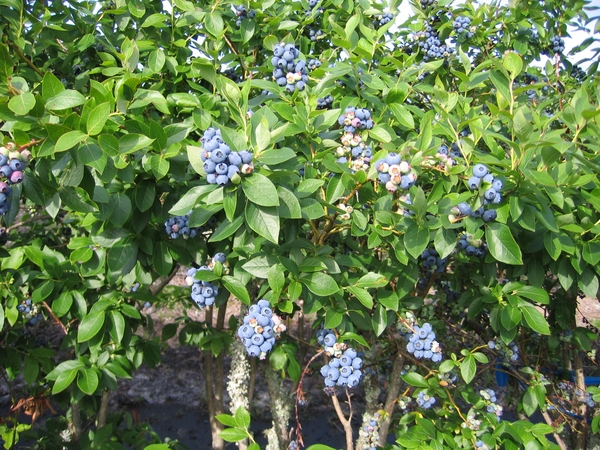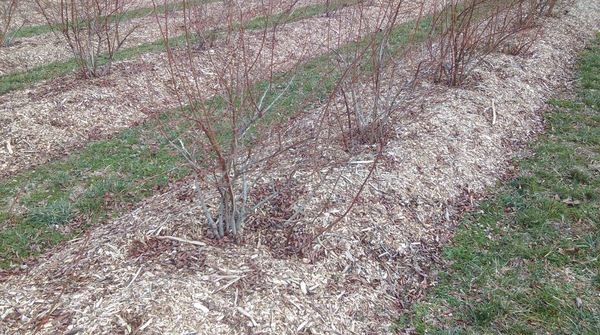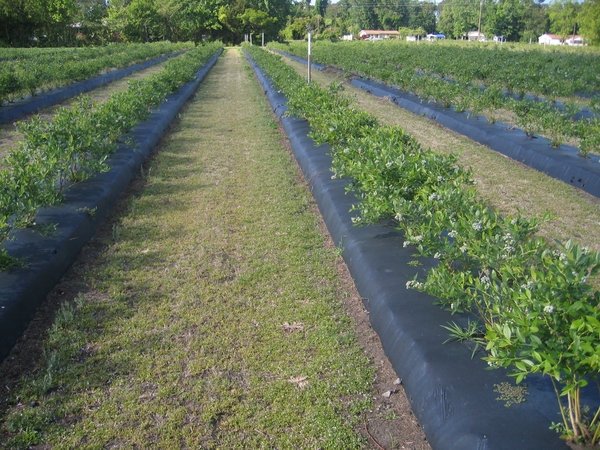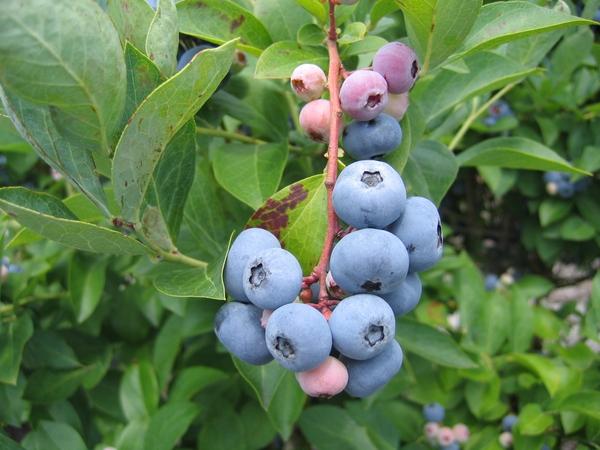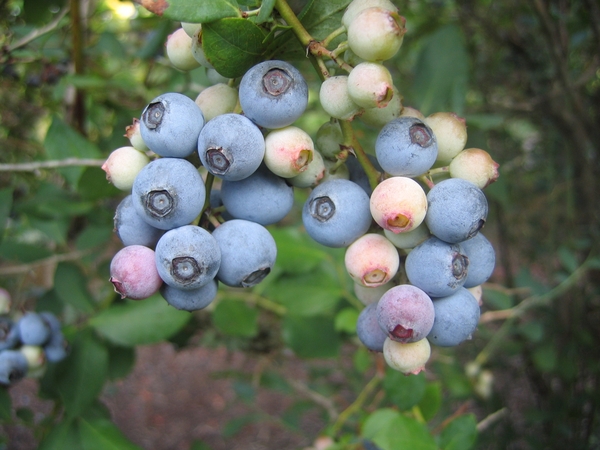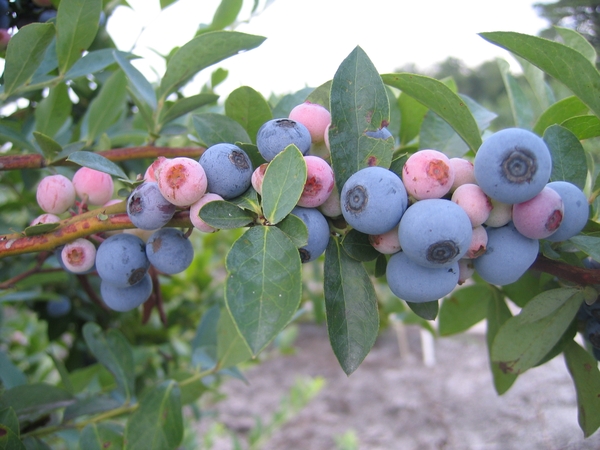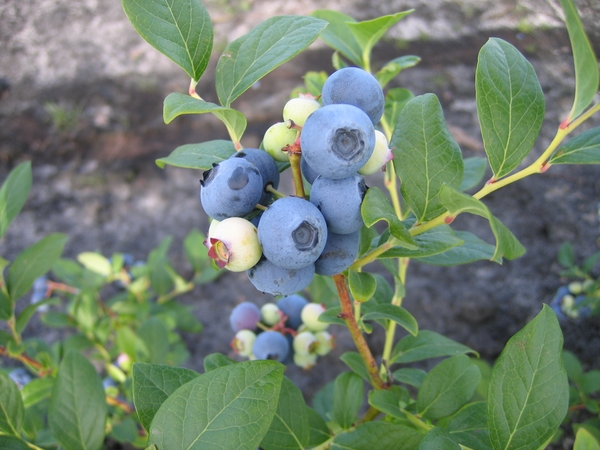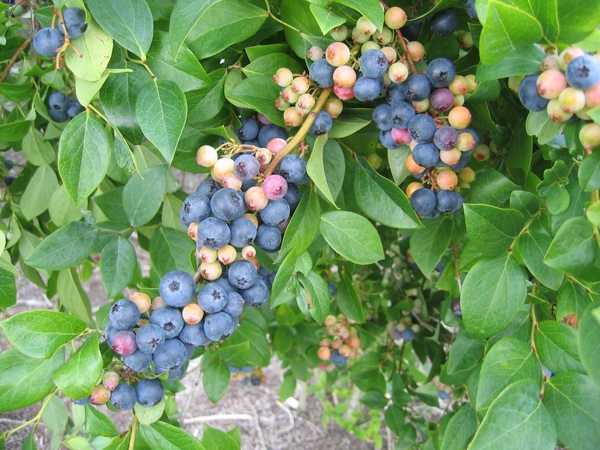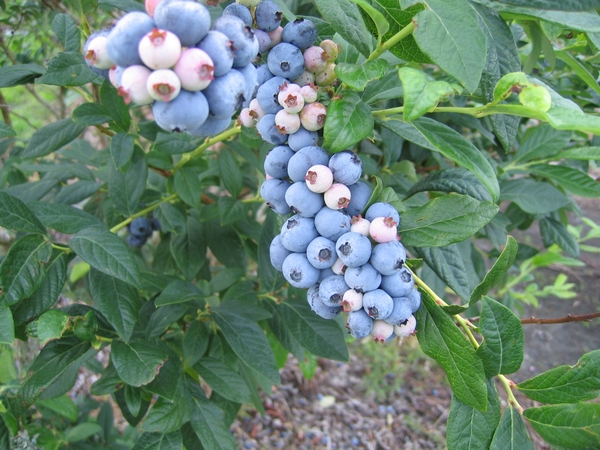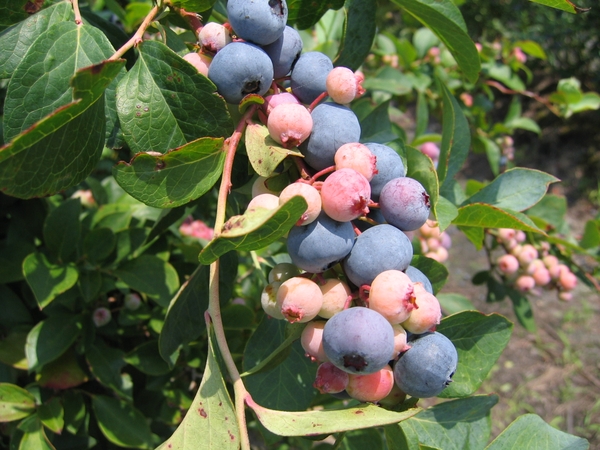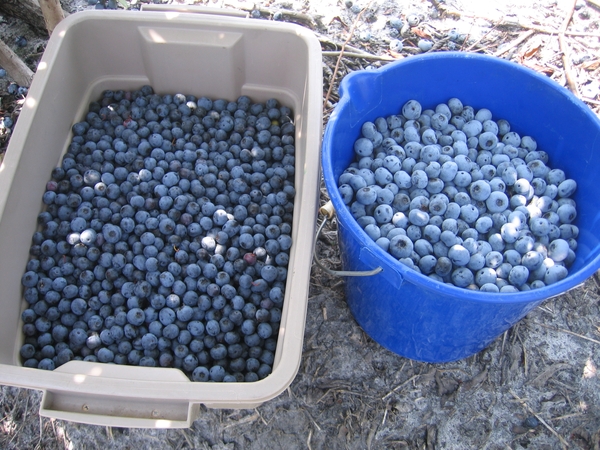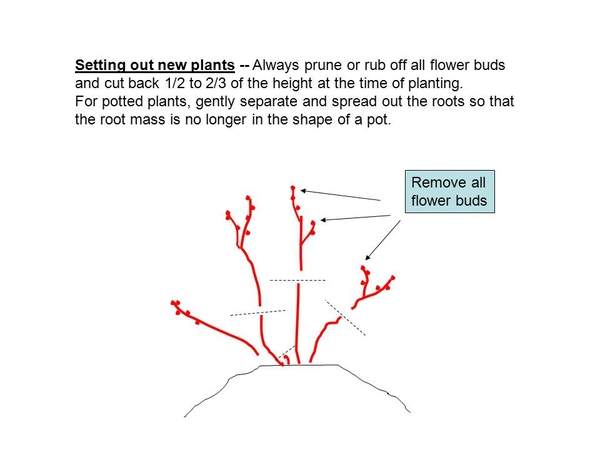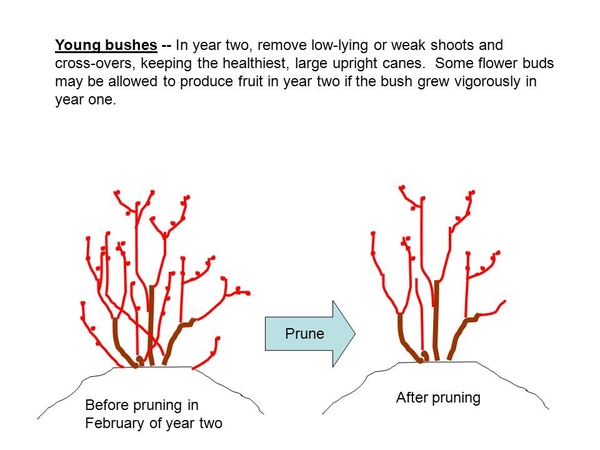INTRODUCTION
Blueberries can be grown in home gardens anywhere in North Carolina if the right species and proper soil modifications are used. Blueberries are typically used in the landscape as hedges for screening purposes, but they can also be used in cluster plantings, or as single specimen plants. Blueberries are an ideal year round addition to the landscape. They have delicate white or pink flowers in the spring, the summer fruit has an attractive sky blue color, and the fall foliage adds great red and yellow colors to the landscape. In addition, blueberry plants lend themselves to the "organic" approach of gardening, since pesticides are rarely needed in home garden plantings.
SITE SELECTION AND PREPARATION
Soil pH
Blueberries require a lower pH than many other small fruit crops. Before planting, take a soil test. Apply wettable sulfur (90% S) if pH is above 5.3 for rabbiteye blueberries or 5.0 for highbush blueberries. Use 1.0 pound (2.5 cups) per 100 square feet on sandy soils to lower pH by 1 unit (for instance, from 6.0 to 5.0). Apply 2.0 pounds per 100 square feet for the same amount of pH lowering on heavier soils containing silt, clay or more than 2% organic matter. Try to achieve a pH of around 4.8; too much reduction can be detrimental to bush growth. Apply sulfur at least 3-4 months before planting, and take another soil test before planting. If pH is still above the acceptable range, additional sulfur can be applied. If you must plant without an initial soil test, mix 1 cubic foot of peat moss with an equal amount of sand. On a heavy clay soil or a soil that sometimes remains wet, put the peat-sand mixture on the soil surface. If you are certain the soil has good internal drainage, part of the peat-sand mixture can go in a hole or furrow several inches below the soil surface. However, leave enough of the peat-sand mixture to form a mound (single plant) or ridge (row of plants) at least 6 inches above the surrounding soil surface (Figure 1). The mound or ridge will provide damage of excess water, however, with this planting method, water thoroughly 2 to 3 times per week during dry periods, because the raised peat-sand mix will dry out quickly. An alternative to peat moss is to use a ground pine bark product that contains a mix of large and small (fine) particles, such as the bagged material sold as "Pine Bark Mulch" at garden centers.
Organic Additions
If the soil contains less than 2% organic matter (HM% or OM on your soil test report) incorporating peat moss, well-decayed pine sawdust or pine bark mulch will improve plant survival and growth. Apply organic material 3 to 4 inches deep over the row in a band 18 to 24 inches wide and incorporate thoroughly using a roto-tiller or spade to a depth of 6 to 8 inches. Preparing the beds in the Fall will allow planting earlier in the season (late February to late March depending on the location). If the organic material is incorporated in the Fall, any sulfur required to lower the pH can be added at the same time. Avoid opening a furrow, adding the organic material and planting directly in the pure organic material -- always mix (incorporate) the organic matter with the native soil, otherwise water and nutrient management is likely to be difficult in the pure organic material and plants are more likely to become weak and die.
Drainage
Drainage is the most important consideration for site selection -- avoid low, concave areas where drainage is poor blueberry plants require excellent soil drainage, so provisions for drainage must precede planting. Soil maps or observing the soil profile may be helpful in predicting internal drainage. Alternatively, digging a "dry well" can be a very effective means of determining soil drainage. Dig a hole(s) 6 to 8 inches deep and observe the water level following heavy rains. Water should not remain in the hole for more than 24 hrs, otherwise select another site or plant on ridges high enough for the water level to reach 6 to 8 inches deep within 24 hrs. Orient rows down rather than across slopes to avoid trapping water.
Irrigation
In most seasons and on most soils, irrigation is absolutely essential the year of planting. Hand watering with a hose is possible for several bushes, however, a soaker hose will usually give more uniform wetting. In larger plantings, systems using micro-sprinklers have been more successful than point-source drippers. On sandy soils, even 2 drippers per plant often do not wet enough of the soil in the root zone. At least 50% of the area under the plant canopy should be wetted. The irrigation system must be designed for the higher output of micro-sprinklers (about 10 gallons per hour) compared with 1 or 2 gallons per hour for drippers. Align the micro-sprinklers to avoid saturated soil around the crown of the bushes. The use of automatic timers on drip or microsprinkler irrigation systems can result in shallow root systems and root rotting if systems apply water daily. Apply irrigation no more than once every two days to reduce the chances of root rot infection.
Sun Versus Shade
Full sun is desirable but up to 50% shade is usually acceptable. However, yield is reduced with increasing shade, so plant in a sunny location to achieve maximum yield.
CHOOSING THE RIGHT SPECIES AND VARIETY
What Species
Both highbush (Vaccinium corymbosum) and rabbiteye (V. virgatum, syn. V. ashei) types of blueberries can be grown in the Coastal Plain and Piedmont. However, only highbush will consistently survive the minimum winter temperatures below 10°F that regularly occur in the mountains -- for this reason, rabbiteye blueberries are not recommended for planting above 2,500 ft elevation in western NC. While less winter cold-hardy, rabbiteye blueberries are more drought and heat resistant and will tolerate a wider range of soil types than highbush, making them easier to establish and grow successfully in the Piedmont and on the drier soils of the Coastal Plain than. More recently, a group of varieties referred to as southern highbush have been released. These varieties are intermediate between highbush and rabbiteye in soil and climate adaptation. Because of their vigor and soil adaptability, rabbiteye blueberries are the best choice for most soils below 2,500 ft elevation in NC.
Varieties
Highbush varieties begin ripening in mid-May in the southeastern Coastal Plain and in early July in the Mountains. Rabbiteye varieties begin in mid-June in the southeastern Coastal Plain. More than one rabbiteye variety should be planted to provide the cross-pollination required for maximum yields. Following are varieties in order of ripening from early to late that have been grown successfully and are recommended for homeowners:
Coastal Plain (for low elevation, high %HM soils) - Highbush: 'Duke', 'Jersey'; Southern highbush: 'O'Neal', 'New Hanover', 'Legacy'
Coastal Plain, Piedmont and Foothills (drier upland soils) - Rabbiteye: 'Climax', 'Premier', 'Centurion', 'Columbus', 'Ira', 'Tifblue', 'Powderblue', 'Onslow'; Southern highbush: 'O'Neal', 'New Hanover', 'Legacy'
Mountains above 2,500 ft - Highbush: 'Duke', 'Sunrise', 'Echota', 'Blueray', 'Bluecrop', 'Toro', 'Berkeley', 'Jersey'
PLANTING AND CARE
Planting
a) Plants - 2 or 3-year old nursery plants 12-36 inches tall will transplant well. The roots must be kept moist at all times between digging and replanting.
b) Time - Late winter (Feb-Mar) as soon as the soil can be worked is best for bare-root plants; Fall (Nov-Dec) planting has been successful on sandy soil in the southeastern Coastal Plain with bareroot plants and in the other areas with potted plants.
c) Spacing - Plant highbush varieties every 4-5 ft in the row and 8-10 ft between rows. Plant rabbiteye varieties 5-6 ft in the row and 10-12 ft between rows.
d) Depth - Plant to the same depth as the plants were growing in the nursery if organic mulch will be applied on the surface. When planting without mulch, plant 1-2 inches deeper to allow for soil settling, firm the soil around the plant with your feet and water thoroughly. On most sites, blueberries will perform better when planted in a raised mound or ridged row that is higher than the surrounding grade.
e) Cut Back - Prune approximately 2⁄3 of the top growth on bare-root plants and 1⁄2 on potted plants leaving only 1-3 of the most vigorous upright shoots. Remove any remaining flower buds (plump rounded buds), so that the plants will not flower the first year.
Fertilization
a) Use Caution - Blueberries are easily damaged by excess fertilizer. Apply the recommended amount from a soil test report and allow 4 inches of rain or an equivalent amount of irrigation between applications.
b) First Year - Do not fertilize immediately after planting. Wait until the first leaves have emerged, then apply 1 Tbs of a special azalea fertilizer, 12-12-12 or 10-10-10 within a circle 1 foot from the plants. Repeat application of fertilizer at 6 week intervals depending upon rainfall or irrigation until mid-August in the Coastal Plain and mid-July in the Mountains. Use 1/2 Tbs of ammonium sulfate instead of the complete fertilizer for the second and subsequent applications if phosphorus was above 60 on the soil test.
c) Second Year - Double the first year rates, but increase the circle around plants to 11⁄2 ft . Apply the first application when new growth begins in spring.
d) Bearing Plants - When growth begins in the spring, apply 1 cup of complete fertilizer such as 10-10-10 within a circle 3 ft from the plant. If more vigorous growth is desired, sidedress with 1⁄4 cup of ammonium sulfate at 6 week intervals. On mature bushes 6-12 inches of new growth is adequate for optimal balance of plant size and yield. Additional growth must be pruned away. This may result in a loss in production, but it is necessary to keep the plants from becoming excessively large. Determine sidedressing requirement based on the amount of shoot growth.
e) Lowering pH - If the soil pH is slightly high in an established planting based on a soil test; then sidedress with ammonium sulfate. If the pH is 0.5 units or more above the acceptable range, apply wettable sulfur in a narrow band under the drip line of the bush at the rate of 0.1 lb per bush (1/4 cup) to lower pH 1 unit.
Mulching
Organic material such as bark, wood chips, sawdust or pine straw as a 3 to 4 inch mulch on the surface after planting results in more uniform soil moisture, reduces soil temperature and generally promotes better bush growth and survival. Pine bark, chips or sawdust have a pH of 3.5 to 4.5 and are more desirable than the same mulches from hardwood with an associated pH above 5.0. However, hardwood mulches on the surface have been satisfactory. Avoid sticky hardwood sawdust that will .seal. the bed and prevent water infiltration.
Weed Control
a) Mulched - Mulching home blueberry plantings is the best form of weed control. If mulch is applied following planting and replaced at the rate of 1 inch per year, few weed problems should develop. Hand pull or hoe the occasional weed growth. If row middles are in sod, mow often to reduce invasion by runnering grasses and weed seeds into the mulched area.
b) Not Mulched - Avoid deep cultivation since blueberry roots are very near the surface. Hoe no more than about 1 inch deep. In addition, hoe often (once every 2 weeks) when weeds are germinating to reduce competition with bush growth and to prevent disturbing the roots that will occur when large weeds are removed.
c) Herbicides - There are some chemical herbicides that homeowners can use to control weeds. Please contact your local county extension agent for current recommendations.
Pruning
a) Highbush - If the plants are cut back severely as recommended following planting, little pruning will be required the second year except removing all flower buds and any weak, damaged or diseased growth. Use a similar pruning strategy the third year with the exception that several flower buds can be left on vigorous shoots. In the fourth year, the bush should be 4-5 ft tall and capable of handling a crop, but carefully thin flower buds to prevent overfruiting and severe permanent bending of young canes under the fruit weight. When bushes are mature, remove old canes that are weak, diseased or damaged; cut back tall, vigorous shoots to force branching at a lower level and to control bush height; and thin fruiting shoots to reduce the number of flower buds by about 50%. Prune during the dormant season. Late winter is most desirable especially in the Mountains.
b) Rabbiteye - During the first 3 years, pruning is very similar to highbush; however, excessively tall and limber shoots will need cutting back to stimulate branching and strengthen the shoot. With mature bushes that are excessively vigorous in spite of low rates of fertilization, cutting back the excessively vigorous shoots in late July will help control bush height and increase yield. Winter pruning of mature bushes is also similar to the recommendation for highbush except detailed thinning of fruiting shoots on each cane is less critical, and more suckers (shoots developing a distance from the crown) will require removal.
Harvest
a) Yield - With good care, mature highbush and rabbiteye plants should produce more than 10 lbs each year. Rabbiteye varieties can on occasion produce up to 25 lbs per plant.
b) Bird Protection - Birds love to harvest blueberries. They can consume the complete crop from a small planting. Plastic or cloth netting draped over the bushes or supported on a framework, while the fruit is ripening, is the only practical control.
c) Frequency - Highbush blueberries will be of best quality when picked every 5-7 days depending upon temperature. Rabbiteye flavor improves if berries are picked less often; about every 10 days allows for maximum flavor with few soft overripe fruit.
Potential for Organic Production
Blueberries can often be grown successfully without insecticides and fungicides outside of the commercial production areas of southeastern North Carolina. Japanese beetles can occasionally cause damage to the fruit during ripening, but the foliage is quite resistant. Susceptible plants such as roses or grapes will usually be defoliated by japanese beetles before injury is seen on blueberries. The low rates of fertilizer required make organic sources a viable alternative. Horse manure has proven to be a suitable source of nitrogen and rock phosphate provides adequate phosphorus. Weeds can be controlled with shallow cultivation or more desirably with mulch.
NURSERY SOURCES AND FURTHER READING
Sources of Plants
Blueberries are propagated vegetatively through the use of cuttings. Both hardwood (winter) and softwood (summer) cuttings can be rooted under mist without the use of rooting hormones. While this can be accomplished by the backyard hobbyist or by a local nursery, the best sources of uniform plants for establishing a new planting are nurseries that specialize in blueberry propagation. Some commercial sources will sell single plants, while others require minimum orders of 50 to 100 plants. A partial list of nurseries is included below.
Bottoms Nursery, 519 Pullians Road, Concord, GA 30206. (770) 884-5661
Finch Blueberry Nursery, 5714 Finch Blueberry Lane, Bailey, NC 27807. (252) 235-4664
Double A Vineyards (716) 672-8493
Nourse Farms, 41 River Road, Whately, MA 01093 (413) 665-2658
For Further Reading
- Blueberry Culture, Rutgers University Press, New Brunswick, NJ
- Blueberry Science, Rutgers University Press, New Brunswick, NJ
- Compendium of Blueberry and Cranberry Diseases. APS Press, St Paul, MN
- Highbush Blueberry Production Guide, NRAES-55, Ithaca, NY
- Southern Region Small Fruit Consortium
Publication date: Nov. 30, 2002
Reviewed/Revised: Feb. 12, 2024
N.C. Cooperative Extension prohibits discrimination and harassment regardless of age, color, disability, family and marital status, gender identity, national origin, political beliefs, race, religion, sex (including pregnancy), sexual orientation and veteran status.

